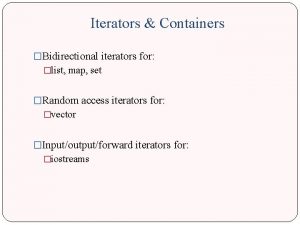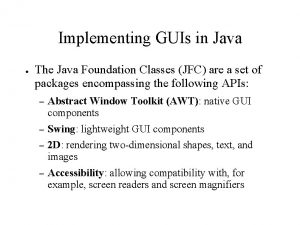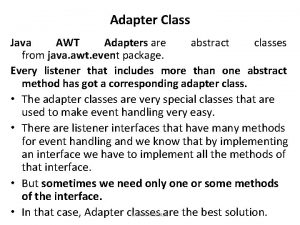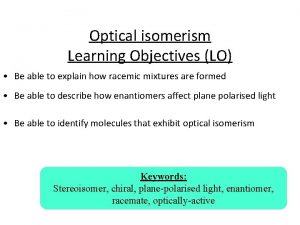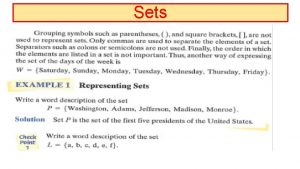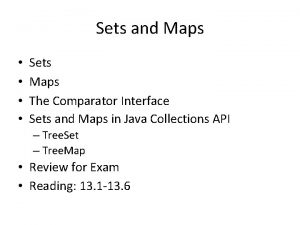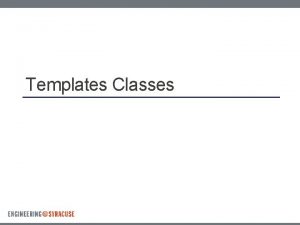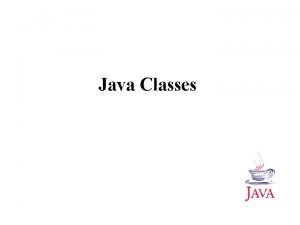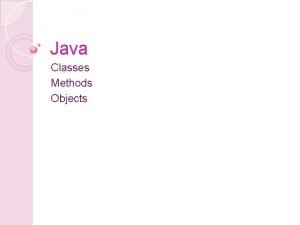JAVA SETS AND MAPS SUMMARY OF CLASSES SETS









- Slides: 9

JAVA SETS AND MAPS

SUMMARY OF CLASSES (SETS) • Enum. Set<E> - Specialized set for enumerated types. Implemented as bitvector. • Hash. Set<E> - Set implemented with chained hash table – no guaranteed iteration order • • Linked. Hash. Set<E> - Same, but with guaranteed iteration order. No complexity overhead E should override both hash. Code() and equals()! Default hash. Code() hashes memory address of object (typically, not always) and default equals() compares memory address • Tree. Set<E> - Set implemeneted with red-black tree. Needs Comparator<E> or E should implement Comparable<E> • There are no multisets in the Java library. Some external libraries have them. • To find how to use them, go to the Java API!

Interfaces Classes Iterable<E> Collection<E> Object Set<E> Abstract. Collection<E> Sorted. Set<E> Abstract. Set<E> Navigable. Set<E> Enum. Set<E> Hash. Set<E> Linked. Hash. Set<E> Tree. Set<E>

EXAMPLE OF USING SET<E> 1. Scanner s = new Scanner(new File(“numbers. txt”)); 2. Hash. Set<Integer> numbers = new Hash. Set<>(); 3. while(s. has. Next. Int()) 4. numbers. add(s. next. Int()); 5. …elsewhere… 6. int sum. Of. Unique = 0; 7. for(Integer i : numbers) 8. sum += i;

EXAMPLE OF OVERRIDING HASCODE() 1. 2. 3. 4. 5. 6. 7. 8. 9. 10. 11. 12. 13. 14. Really great stackoverflow answer public class Student { about creating hash codes. String id; //unique! String name; List<Courses> courses; …stuff… public boolean equals(Object obj) { if(obj != null && obj instanceof Student) return id. equals(((Student)obj). id); return false; } public int hash. Code() { return id. hash. Code(); } }

SUMMARY OF CLASSES (MAPS) • Enum. Map<K, V> - Specialized set for enumerated types. Implemented as bitvector. • Hash. Map<K, V> - Set implemented with chained hash table – no guaranteed iteration order • • Linked. Hash. Map<K, V> - Same, but with guaranteed iteration order. No complexity overhead K should override both hash. Code() and equals()! Default hash. Code() hashes memory address of object (typically, not always) and default equals() compares memory address • Tree. Map<K, V> - Set implemeneted with red-black tree. Needs Comparator<K> or K should implement Comparable<K> • Identity. Hash. Map<K, V> - hash map specifically for objects that use reference equality instead of object equality • Weak. Hash. Map<K, V> - Like a hash map, but does not prevent garbage collector from removing keys • There are no multisets in the Java library. Can fake with Map<K,

Interfaces Classes Map<K, V> Object Sorted. Map<E> Abstract. Map<K, V> Navigable. Map<E> Enum. Map<K, V> Hash. Map<K, V> Tree. Map<K, V> Linked. Hash. Map<K, V> Identity. Hash. Map<K, V> Weak. Hash. Map<K, V>

EXAMPLE OF USING MAP<K, V> 1. Scanner s = new Scanner(new File(“numbers. txt”)); 2. Hash. Map<Integer, String> numbers = new Hash. Map<>(); 3. while(s. has. Next. Int()) 4. numbers. put(s. next. Int(), s. next()); 5. …elsewhere… 6. System. out. println(numbers. get(5)); //get a value

PROBLEM • Design a barcode scanner for a super market: Given the barcodes of the items in your shopping list, look up in the inventory database for its availability and if available print the quantity. • What will be the underlying container? • Read the inventory data (item barcode, quantity, per item cost) from the file given in the website. • Bonus: Prepare the receipt (total cost) for the shopping list. • You may format a shopping list any way you want. Be sure to handle the case where the item does not exist!

